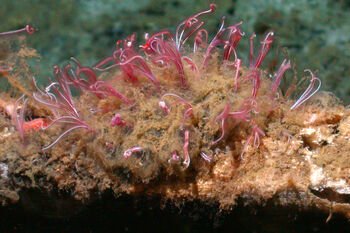
Monitoring their activity across the seasons is crucial for understanding marine ecosystems. Think of it like tracking the changing colors of leaves in fall or the migration of birds—only instead of trees or skies, we’re diving into the depths of the ocean. To keep an eye on these unique worms, researchers use various tools and methods, including remote monitoring systems. Brands like SeaTech offer some advanced tech to help track their activity patterns throughout the year, which can reveal insights into broader environmental changes.
What Are Bone-Eating Worms?
Bone-eating worms, scientifically known as *Osedax*, are creatures that thrive in some of the ocean’s most extreme environments. These worms have a unique lifestyle, feeding directly on the bones of dead marine animals. Imagine a scavenger at a feast, where the main dish is dinner leftovers that have sunk to the ocean floor. These worms have special enzymes that allow them to break down the bone, extracting valuable nutrients like lipids and proteins.
One of the most interesting features of these worms is their bright colors, often ranging from deep reds to vibrant greens. Their appearance is striking, making them stand out against the surrounding sea floor. Honestly, they look like something straight out of a science fiction novel! Additionally, they’re usually found in clusters, giving the ocean floor a unique, almost otherworldly appearance when you encounter them.
Why Monitor Bone-Eating Worms?
Monitoring bone-eating worms is more than just academic curiosity; it has real implications for our understanding of marine ecosystems. As these worms play a vital role in breaking down organic matter, observing their activity can reveal how nutrients are recycled in the ocean. Think of the ocean as a massive engine, where every part needs to work smoothly to keep things running. If the bone-eating worms aren’t thriving, it might indicate something amiss within that system.
Seasonal changes also reflect how these creatures adapt to their environment. For example, temperature fluctuations, nutrient availability, and even ocean currents can all impact worm behavior. You might be wondering how scientists can track these seasonal shifts. Advanced tools like underwater cameras and remote sensors help collect data on worm populations and their feeding habits year-round.
The Seasonal Life Cycle of Bone-Eating Worms
Like many organisms, bone-eating worms undergo changes throughout the year. In the spring, increased marine life can lead to more food sources as animals die and sink. This can result in a surge in worm populations. It’s like springtime for them, where they have a buffet of bones to feed on.
In contrast, during the winter months, their activity may slow down. Colder temperatures can reduce the number of decomposing organisms available, leading to a drop in worm numbers. However, don’t count them out completely! These resilient worms have adapted to survive in harsh conditions, often going into a sort of dormancy until the warmer months bring more food.
Using Technology for Monitoring
So, how do scientists keep tabs on these fascinating creatures? The secret lies in technology. Remote monitoring systems are crucial for understanding bone-eating worm activity. Researchers often use underwater cameras, sensors, and monitoring platforms to gather information about the ocean floor. This tech can take images, record data, and even analyze water conditions—all without disturbing the marine environment.
For example, a brand like SeaTech offers various remote sensing devices that help researchers monitor not just the worms, but the entire ecosystem. With these tools, it’s easier to sync data over time, allowing scientists to track changes in real-time. If you think of the ocean as a vast library of information, these technologies are the bookmarks that help scientists navigate through the pages.
Challenges in Monitoring
While monitoring bone-eating worms sounds straightforward, it comes with its own set of challenges. The deep ocean is a tricky place to work. High pressures, extreme temperatures, and difficult access make it hard to conduct studies. Sometimes, monitoring equipment can fail or get damaged, disrupting data collection. Imagine trying to take a photo on a rollercoaster—it’s fast, unpredictable, and challenging to get it just right.
Additionally, environmental changes such as climate change and pollution can impact worm populations. Monitoring these factors adds another layer of complexity. Scientists must continually adapt their methods, often working in teams to make sense of the data they collect. It’s a collaborative effort, not just for the study of these worms, but for the health of the entire marine ecosystem.
The Future of Monitoring Bone-Eating Worms
As technology advances, the future of monitoring bone-eating worms looks promising. With improvements in remote sensing and data analysis, researchers can obtain clearer images and more accurate data than ever before. Imagine using artificial intelligence to predict when and where worms will be most active based on historical data. This could lead to more effective conservation strategies and a deeper understanding of marine life.
Innovations like underwater drones are also paving the way for more extensive studies. These drones can access areas of the ocean that were previously unreachable, making it easier to monitor these fascinating creatures in their natural habitat. It’s exciting to think about what new discoveries await as we dive deeper into the mysteries of the ocean.
Monitoring bone-eating worm activity across the seasons is not just an academic pursuit; it’s essential for understanding our oceans and the ecosystems within them. These unique little creatures play a critical role in recycling nutrients and maintaining balance in the marine environment. As we use advanced technology to track their activity, we uncover more about the health of the ocean and how it responds to environmental changes.
So, next time you think about the depths of the ocean, remember the bone-eating worms and the important work they do. They may be small, but their impact is significant. Keeping an eye on their activity helps us ensure that our oceans remain vibrant and full of life for generations to come.
